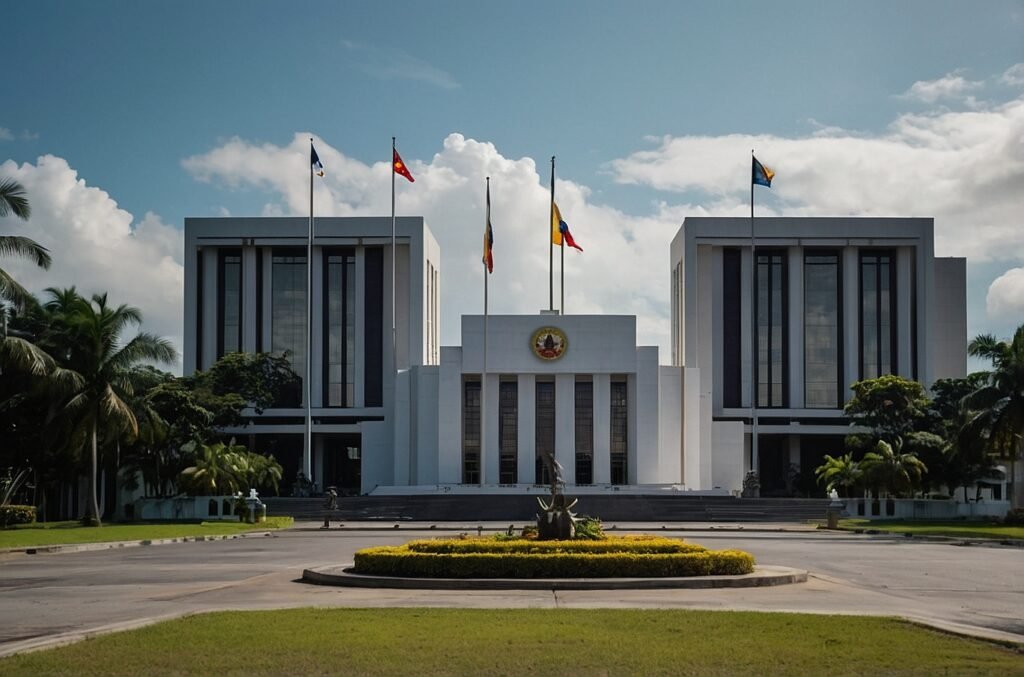The Philippines, an archipelagic nation in Southeast Asia, has a complex system of governance that relies heavily on local government units (LGUs) to deliver essential services and implement policies at the grassroots level. This blog post delves into the intricate workings of local government in the Philippines, exploring its structure, functions, challenges, and significance in the country’s overall governance framework. By understanding the role of local government, we can better appreciate its impact on the daily lives of Filipino citizens and its contribution to national development.
Historical Context of Local Governance in the Philippines
The roots of local governance in the Philippines can be traced back to pre-colonial times when barangays, the smallest political units, were led by datus or chieftains. Over the centuries, the system evolved through Spanish colonial rule, American occupation, and eventually, independence. The modern structure of local government in the Philippines was largely shaped by the Local Government Code of 1991, which devolved significant powers and responsibilities to LGUs.
Key Milestones in Philippine Local Governance:
- Pre-colonial era: Barangay system under datus
- Spanish colonial period (1565-1898): Introduction of pueblo (town) system
- American colonial period (1898-1946): Expansion of local autonomy
- Post-independence (1946-1991): Centralized governance with limited local authority
- 1991: Enactment of the Local Government Code (Republic Act 7160)
- Present: Continued implementation and refinement of decentralized governance
The Local Government Code of 1991 marked a significant shift towards decentralization, granting LGUs more autonomy in managing their affairs and resources. This legislative landmark aimed to empower local communities, improve service delivery, and promote grassroots democracy. Since its implementation, the Code has undergone several amendments to address emerging challenges and enhance its effectiveness in the changing landscape of Philippine governance.
Structure of Local Government in the Philippines
The Philippine local government system is organized into a hierarchical structure, with each level having distinct roles and responsibilities. This multi-tiered approach allows for a more targeted and efficient delivery of public services, as well as a more responsive governance structure that can address the specific needs of different localities.
Levels of Local Government Units:
- Provinces
- Headed by a Governor
- Composed of municipalities and component cities
- Cities
- Classified as Highly Urbanized, Independent Component, or Component
- Led by a Mayor
- Municipalities
- Smaller than cities, typically rural or semi-urban areas
- Also led by a Mayor
- Barangays
- The smallest administrative division
- Headed by a Barangay Captain
Each level of local government has its own set of elected officials, including a chief executive (Governor for provinces, Mayor for cities and municipalities, and Barangay Captain for barangays) and a legislative body (Sanggunian). This structure ensures that there is representation and governance at every level, from the broad provincial scope down to the neighborhood-level barangays.
To illustrate the hierarchy and distribution of LGUs in the Philippines, here is a table showing the current numbers as of 2024:
| LGU Type | Number |
|---|---|
| Provinces | 81 |
| Cities | 146 |
| Municipalities | 1,488 |
| Barangays | 42,046 |
This multi-layered structure allows for a more nuanced approach to governance, where each level can focus on issues and services most relevant to its scope and jurisdiction. It also facilitates a more direct connection between citizens and their local leaders, promoting accountability and responsiveness in governance.
Functions and Responsibilities of Local Government Units
Local Government Units in the Philippines are tasked with a wide array of functions and responsibilities that directly impact the daily lives of citizens. These roles span various sectors and are crucial for the overall development and well-being of local communities. The Local Government Code of 1991 outlines these functions, which can be broadly categorized into several key areas.
Key Functional Areas of LGUs:
- Basic Services Provision
- Health and sanitation
- Social welfare services
- Environmental management
- Public works and infrastructure
- Economic Development
- Local economic planning
- Revenue generation and budgeting
- Investment promotion
- Peace and Order
- Maintenance of local peace and security
- Disaster preparedness and response
- Education and Culture
- Support for local educational institutions
- Promotion of cultural heritage and arts
- Governance and Administration
- Local legislation and policy-making
- Human resource management
- Inter-governmental relations
Each level of local government has specific responsibilities within these functional areas. For instance, provinces often focus on larger-scale initiatives and coordination among municipalities, while barangays are more involved in day-to-day community affairs and grassroots service delivery.
To provide a more detailed look at how responsibilities are distributed across different LGU levels, consider the following table:
| Function | Province | City/Municipality | Barangay |
|---|---|---|---|
| Health Services | Provincial hospitals, health programs | City/municipal health centers | Barangay health stations |
| Education | Provincial schools, scholarships | City/municipal schools, libraries | Day care centers |
| Infrastructure | Provincial roads, bridges | City/municipal roads, public buildings | Barangay halls, small-scale projects |
| Environmental Management | Provincial environmental programs | Waste management, local conservation | Community clean-up drives |
| Economic Development | Provincial investment programs | Local business regulation, markets | Livelihood programs |
This distribution of responsibilities ensures that each level of government can focus on tasks most appropriate to its scope and capacity. It also allows for a more efficient allocation of resources and a more targeted approach to addressing local needs and challenges.
Fiscal Management and Revenue Generation
One of the most critical aspects of local governance is fiscal management and the ability to generate revenue. The Local Government Code grants LGUs significant fiscal autonomy, allowing them to raise their own funds and manage their budgets. This financial independence is crucial for LGUs to effectively carry out their functions and implement development projects.
Sources of LGU Revenue:
- Local Taxes and Fees
- Real property tax
- Business taxes
- Regulatory fees
- Internal Revenue Allotment (IRA)
- Share from national government tax collections
- Other Income Sources
- Economic enterprises
- Loans and bonds
- Grants and donations
The ability of LGUs to generate and manage their own resources is a key factor in their effectiveness. However, there are significant disparities in the fiscal capacities of different LGUs, with some struggling to meet their financial needs while others have surplus funds.
To illustrate the fiscal landscape of LGUs, here’s a chart showing the average distribution of revenue sources for LGUs in the Philippines:
Revenue Sources for LGUs:
Local Taxes and Fees: 35% ████████████████████
IRA: 45% ██████████████████████████
Other Income Sources: 20% ████████████This chart demonstrates the heavy reliance of many LGUs on the Internal Revenue Allotment from the national government, which often accounts for a significant portion of their budget. Enhancing local revenue generation capabilities remains a key challenge and priority for many LGUs to reduce dependence on national government transfers and improve fiscal autonomy.
Challenges Facing Local Governance in the Philippines
Despite the progress made since the implementation of the Local Government Code, local governance in the Philippines faces numerous challenges that impact its effectiveness and efficiency. These challenges range from structural issues to socio-economic factors and require ongoing attention and reform efforts.
Key Challenges:
- Resource Disparities
- Uneven distribution of resources among LGUs
- Limited fiscal capacity of many local governments
- Capacity and Skill Gaps
- Lack of technical expertise in some LGUs
- Need for continuous training and development of local officials
- Political Dynamics
- Influence of political dynasties
- Potential for corruption and mismanagement
- Coordination Issues
- Overlapping functions between different levels of government
- Challenges in inter-LGU cooperation
- Demographic and Geographic Challenges
- Rapid urbanization in some areas
- Difficulty in service delivery to geographically isolated areas
These challenges often intersect and compound each other, creating complex situations that require multifaceted solutions. For instance, resource disparities can exacerbate capacity gaps, while political dynamics can influence resource allocation and policy implementation.
To provide a more nuanced view of these challenges, consider the following data on LGU performance based on the Department of the Interior and Local Government’s (DILG) assessment:
| Performance Category | Percentage of LGUs |
|---|---|
| Excellent | 15% |
| Very Satisfactory | 30% |
| Satisfactory | 40% |
| Needs Improvement | 15% |
This data suggests that while many LGUs are performing adequately, there is still significant room for improvement across the board. Addressing these challenges requires a combination of policy reforms, capacity-building initiatives, and enhanced accountability measures.
Innovations and Best Practices in Local Governance
Despite the challenges, many LGUs in the Philippines have implemented innovative approaches and best practices that have significantly improved local governance. These success stories serve as models for other LGUs and demonstrate the potential for creative problem-solving at the local level.
Areas of Innovation:
- E-Governance and Digital Transformation
- Online service portals
- Digital payment systems
- Data-driven decision making
- Participatory Governance
- Community-based planning and budgeting
- Citizen feedback mechanisms
- Environmental Sustainability
- Eco-friendly urban planning
- Renewable energy initiatives
- Public-Private Partnerships
- Collaboration with businesses for service delivery
- Joint ventures for infrastructure development
- Social Innovation
- Community-based health programs
- Local education initiatives
These innovations have led to improved service delivery, increased citizen engagement, and more efficient use of resources in many LGUs. For example, the city of Makati has been recognized for its comprehensive e-governance system, which has streamlined services and reduced corruption. Similarly, the municipality of San Vicente in Palawan has gained attention for its sustainable tourism practices that balance economic development with environmental conservation.
To highlight the impact of these innovations, here’s a comparison of key performance indicators before and after the implementation of innovative practices in a sample of LGUs:
| Indicator | Before Innovation | After Innovation | Improvement |
|---|---|---|---|
| Citizen Satisfaction | 65% | 85% | +20% |
| Service Delivery Time | 7 days | 3 days | -57% |
| Revenue Collection | ₱100M | ₱150M | +50% |
| Environmental Compliance | 70% | 95% | +25% |
These figures demonstrate the significant positive impact that innovative approaches can have on various aspects of local governance. As more LGUs adopt and adapt these best practices, the overall quality of local governance in the Philippines is likely to improve.
The Role of Local Government in National Development
Local governments play a crucial role in the overall development of the Philippines. As the level of government closest to the people, LGUs are uniquely positioned to understand and address the specific needs and challenges of their communities. This grassroots approach to development is essential for inclusive and sustainable growth across the country.
Key Contributions of LGUs to National Development:
- Implementation of National Policies
- Localization of national development plans
- Execution of national programs at the local level
- Economic Growth
- Promotion of local industries
- Creation of favorable business environments
- Poverty Alleviation
- Targeted social welfare programs
- Livelihood development initiatives
- Disaster Resilience
- Local climate change adaptation
- Disaster risk reduction and management
- Social Development
- Improvement of local health and education systems
- Promotion of cultural preservation and development
The effectiveness of LGUs in these areas directly impacts the achievement of national development goals. For instance, the success of poverty reduction efforts heavily depends on the ability of local governments to implement targeted interventions and create economic opportunities in their localities.
To illustrate the impact of local governance on national development indicators, consider the following graph showing the correlation between LGU performance (as measured by the DILG’s Seal of Good Local Governance) and key development metrics:
LGU Performance vs Development Indicators:
Poverty Reduction: ██████████████████████ 80%
Economic Growth: ███████████████████ 75%
Education Outcomes: ████████████████ 65%
Health Indicators: ███████████████████ 75%
Disaster Resilience: ██████████████████ 70%
(Percentage indicates positive correlation)This graph demonstrates the strong positive correlation between effective local governance and improvements in various development indicators. It underscores the critical role that LGUs play in translating national policies and programs into tangible benefits for local communities.
Future Directions and Reforms
As the Philippines continues to develop and face new challenges, the role of local government is likely to evolve. There are ongoing discussions and initiatives aimed at further enhancing the effectiveness and efficiency of local governance in the country.
Key Areas for Future Reform:
- Federalism Debates
- Proposals for a shift to a federal system of government
- Potential impacts on local autonomy and resource allocation
- Enhanced Decentralization
- Further devolution of powers to LGUs
- Strengthening of local fiscal autonomy
- Capacity Building
- Continuous training and development programs for local officials
- Enhanced technical support from national agencies
- Digital Transformation
- Wider adoption of e-governance systems
- Integration of emerging technologies in local governance
- Sustainable Development
- Alignment of local development plans with SDGs
- Promotion of green governance practices
These potential reforms aim to address current challenges and prepare local governments for future demands. The success of these initiatives will depend on factors such as political will, resource availability, and the capacity of LGUs to adapt to change.
To provide a perspective on the priorities for local governance reform, here’s a chart showing the results of a survey among local government officials:
Priorities for Local Governance Reform:
Fiscal Autonomy: ████████████████████ 40%
Capacity Development: ██████████████ 30%
Digital Transformation: ████████ 15%
Sustainable Development: ██████ 10%
Inter-LGU Cooperation: ████ 5%
(Percentage indicates priority level)This chart highlights the areas that local officials consider most critical for improving local governance. It suggests that while fiscal concerns remain a top priority, there is also significant interest in enhancing the capabilities of LGUs and embracing new technologies and sustainable practices.
Conclusion
Local government plays a vital and multifaceted role in the governance and development of the Philippines. From providing basic services to driving economic growth and implementing national policies, LGUs are at the forefront of efforts to improve the lives of Filipino citizens. While challenges persist, the innovative approaches and best practices emerging from various LGUs demonstrate the potential for effective local governance to make a significant positive impact.
As the Philippines continues to navigate complex social, economic, and environmental challenges, the role of local government will remain crucial. The ongoing efforts to reform and strengthen local governance structures and practices will be key to ensuring that LGUs can effectively meet the evolving needs of their communities and contribute to the overall development of the nation.
The future of local governance in the Philippines will likely be shaped by a combination of policy reforms, technological advancements, and changing societal expectations. By building on the foundations laid by the Local Government Code and embracing innovation and best practices, local governments can continue to play a pivotal role in shaping a more prosperous, equitable, and sustainable future for the Philippines.
Disclaimer: This blog post is based on current information and data available at the time of writing. While every effort has been made to ensure accuracy, local government structures and policies may be subject to change. Readers are encouraged to verify specific details with official sources and to report any inaccuracies so we can correct them promptly.




